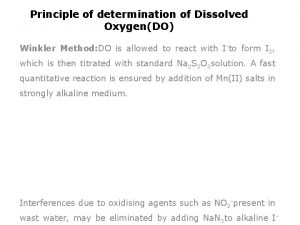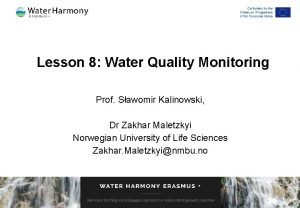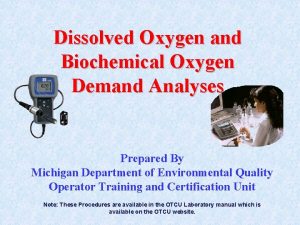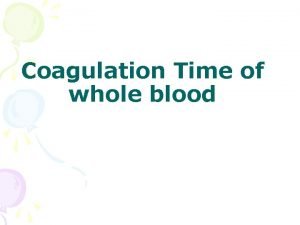Principle of determination of Dissolved OxygenDO Winkler Method





- Slides: 5

Principle of determination of Dissolved Oxygen(DO) Winkler Method: DO is allowed to react with I-to form I 2, which is then titrated with standard Na 2 S 2 O 3 solution. A fast quantitative reaction is ensured by addition of Mn(II) salts in strongly alkaline medium. Interferences due to oxidising agents such as NO 2 -present in wast water, may be eliminated by adding Na. N 3 to alkaline I-

• Principle for the determination of Chemical Oxygen Demand(COD) • It is a rapidly measurable parameter for stream and industrial waste studies and control of water treatment plants. The method is based on the chemical oxidation of material in the presence of a catalyst by Cr 2 O 72 -in 50% H 2 SO 4.

Biochemicaloxygen demand(BOD) • The degree of microbially mediated O 2 consumption in water is known as the biochemical oxygen demand. This parameter is commonly measured the quantity of O 2 utilised by suitable aquatic microorganisms during 5 day period. • Where D 1= DO of diluted sample; D 2= DO of diluted sample after incubation; B 1 and B 2 are DO of dilution water containing seed before and after incubation. f=

Total Organic Carbon(TOC) It is an instrumental method and superior than COD method and is quit popular. The oxidising agent is K 2 Cr 2 O 8 and the oxidation is promoted by the free radical HO. Generated from UV light. At the end of the oxidation, CO 2 is sparged from the system and measured with a gas chromatographic detector or by absorption in ultrapure water followed by conductivity measurement.

COD is always higher than BOD • BOD (Biological Oxygen Demand) means the amount of oxygen (in mg/l) microorganisms like bacteria need to 'consume' the organic pollutants (sugars, fat, proteins etc. ). BODvalue in polluted water is normally higher than the fresh water. Increased BOD can be resulted due to domestic sewage, petroleum residues and organic wastes etc, • COD (Chemical Oxygen Demand) is the amount of oxygen required to degenerate all pollution in a chemicalway. In general with industrial waste that typically has high inorganic loads you can remove more pollution via chemical destruction than with the biological way. • As BOD is only a measurement of consumed oxygen by aquatic microorganisms to decompose or oxidize organic matter and COD refers the requirement of dissolved oxygen for both the oxidation of organic and inorganic constituents. COD levels in waste streams are always higher than BOD.









